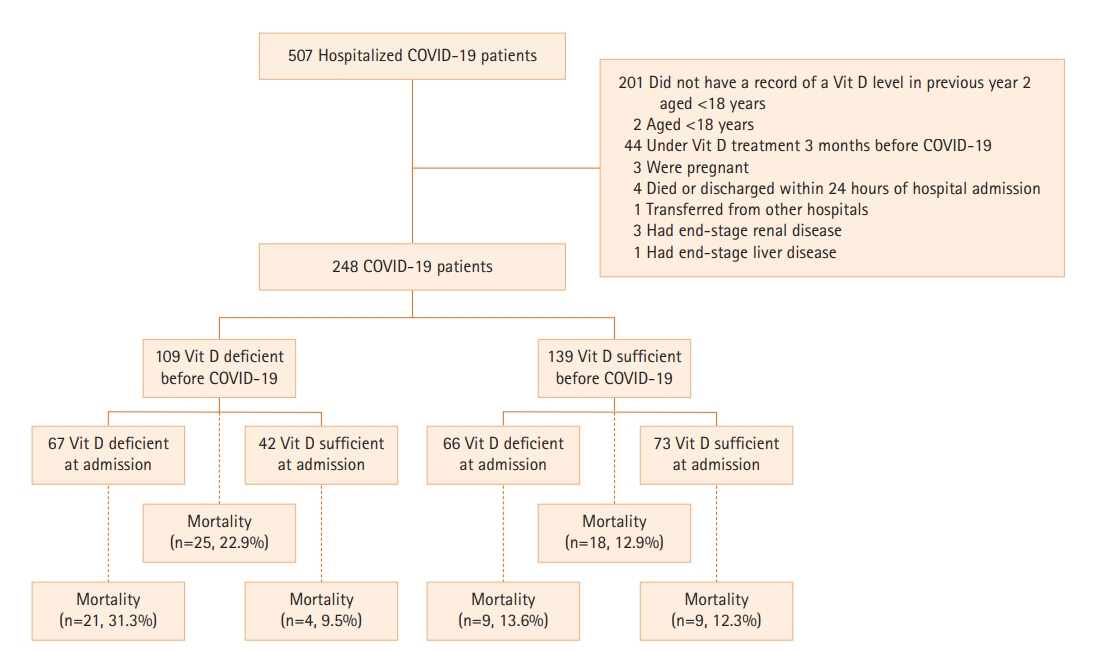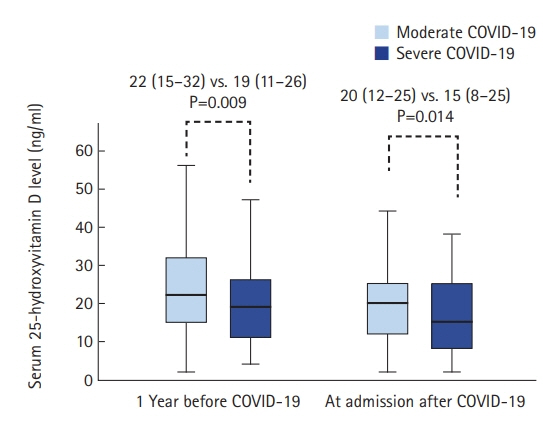Acute Crit Care.
2021 Nov;36(4):300-307. 10.4266/acc.2021.00605.
Association of vitamin D deficiency with COVID-19 severity and mortality in Iranian people: a prospective observational study
- Affiliations
-
- 1Men's Health and Reproductive Health Research Center, Shahid Beheshti University of Medical Sciences, Tehran, Iran
- 2Department of Anesthesiology and Critical Care, Shohadaye Tajrish Hospital, Shahid Beheshti University of Medical Sciences, Tehran, Iran
- 3Department of Cellular and Molecular Nutrition, Faculty of Nutrition and Food Technology, National Nutrition and Food Technology Research Institute, Shahid Beheshti University of Medical Sciences, Tehran, Iran
- 4Student Research Committee, Faculty of Nutrition and Food Technology, National Nutrition and Food Technology Research Institute, Shahid Beheshti University of Medical Sciences, Tehran, Iran;
- 5Department of Nutrition and Food Science, California State University, Chico, CA, USA
- KMID: 2524312
- DOI: http://doi.org/10.4266/acc.2021.00605
Abstract
- Background
As the coronavirus disease 2019 (COVID-19) pandemic continues to escalate, it is important to identify the prognostic factors related to increased mortality and disease severity. To assess the possible associations of vitamin D level with disease severity and survival, we studied 248 hospitalized COVID-19 patients in a single center in a prospective observational study from October 2020 to May 2021 in Tehran, Iran.
Methods
Patients who had a record of their 25-hydroxyvitamin D level measured in the previous year before testing positive with COVID-19 were included. Serum 25-hydroxyvitamin D level was measured upon admission in COVID-19 patients. The associations between clinical outcomes of patients and 25-hydroxyvitamin D level were assessed by adjusting for potential confounders and estimating a multivariate logistic regression model.
Results
The median (interquartile range) age of patients was 60 years (44–74 years), and 53% were male. The median serum 25-hydroxyvitamin D level prior to admission decreased with increasing COVID-19 severity (P=0.009). Similar findings were obtained when comparing median serum 25-hydroxyvitamin D on admission between moderate and severe patients (P=0.014). A univariate logistic regression model showed that vitamin D deficiency prior to COVID-19 was associated with a significant increase in the odds of mortality (odds ratio, 2.01; P=0.041). The Multivariate Cox model showed that vitamin D deficiency on admission was associated with a significant increase in risk for mortality (hazard ratio, 2.35; P=0.019).
Conclusions
Based on our results, it is likely that deficient vitamin D status is associated with increased mortality in COVID-19 patients. Thus, evaluating vitamin D level in COVID-19 patients is warranted.
Figure
Reference
-
1. Worldometer. COVID-19 corona virus pandemic. Worldometer; 2021 [cited 2021 May 10]. Available from: https://www.worldometers.info/coronavirus/ .2021.2. Weiss P, Murdoch DR. Clinical course and mortality risk of severe COVID-19. Lancet. 2020; 395:1014–5.
Article3. Holick MF. The vitamin D deficiency pandemic: approaches for diagnosis, treatment and prevention. Rev Endocr Metab Disord. 2017; 18:153–65.
Article4. Charoenngam N, Holick MF. Immunologic effects of vitamin d on human health and disease. Nutrients. 2020; 12:2097.
Article5. Zdrenghea MT, Makrinioti H, Bagacean C, Bush A, Johnston SL, Stanciu LA. Vitamin D modulation of innate immune responses to respiratory viral infections. Rev Med Virol. 2017; 27:e1909.
Article6. Luo X, Liao Q, Shen Y, Li H, Cheng L. Vitamin D deficiency is associated with COVID-19 Incidence and disease severity in Chinese people [corrected]. J Nutr. 2021; 151:98–103.7. Aslan MT, Aslan İÖ, Özdemir Ö. Letter to the editor: is vitamin d one of the key elements in COVID-19 days? J Nutr Health Aging. 2020; 24:1038–9.8. Herr C, Shaykhiev R, Bals R. The role of cathelicidin and defensins in pulmonary inflammatory diseases. Expert Opin Biol Ther. 2007; 7:1449–61.
Article9. Agier J, Efenberger M, Brzezińska-Błaszczyk E. Cathelicidin impact on inflammatory cells. Cent Eur J Immunol. 2015; 40:225–35.10. Yisak H, Ewunetei A, Kefale B, Mamuye M, Teshome F, Ambaw B, et al. Effects of vitamin D on COVID-19 infection and prognosis: a systematic review. Risk Manag Healthc Policy. 2021; 14:31–8.
Article11. Liu N, Sun J, Wang X, Zhang T, Zhao M, Li H. Low vitamin D status is associated with coronavirus disease 2019 outcomes: a systematic review and meta-analysis. Int J Infect Dis. 2021; 104:58–64.
Article12. Pereira M, Dantas Damascena A, Galvão Azevedo LM, de Almeida Oliveira T, da Mota J. Vitamin D deficiency aggravates COVID-19: systematic review and meta-analysis. Crit Rev Food Sci. Nutr 2020 Nov 4 [EPUB]. https://doi.org/10.1080/10408398.2020.1841090.
Article13. World Health Organization. Clinical management of severe acute respiratory infection when novel coronavirus (2019-nCoV) infection is suspected: interim guidance, 28 January 2020 [Internet]. Geneva: World Health Organization; 2020 [cited 2021 May 10]. Available from: https://apps.who.int/iris/handle/10665/330893.14. Holick MF, Binkley NC, Bischoff-Ferrari HA, Gordon CM, Hanley DA, Heaney RP, et al. Evaluation, treatment, and prevention of vitamin D deficiency: an Endocrine Society clinical practice guideline. J Clin Endocrinol Metab. 2011; 96:1911–30.
Article15. Bhatraju PK, Ghassemieh BJ, Nichols M, Kim R, Jerome KR, Nalla AK, et al. COVID-19 in critically ill patients in the Seattle Region: case series. N Engl J Med. 2020; 382:2012–22.16. Ilie PC, Stefanescu S, Smith L. The role of vitamin D in the prevention of coronavirus disease 2019 infection and mortality. Aging Clin Exp Res. 2020; 32:1195–8.
Article17. D'Avolio A, Avataneo V, Manca A, Cusato J, De Nicolò A, Lucchini R, et al. 25-Hydroxyvitamin D concentrations are lower in patients with positive PCR for SARS-CoV-2. Nutrients. 2020; 12:1359.18. Meltzer DO, Best TJ, Zhang H, Vokes T, Arora V, Solway J. Association of vitamin D status and other clinical characteristics with COVID-19 test results. JAMA Netw Open. 2020; 3:e2019722.
Article19. Radujkovic A, Hippchen T, Tiwari-Heckler S, Dreher S, Boxberger M, Merle U. Vitamin D deficiency and outcome of COVID-19 patients. Nutrients. 2020; 12:2757.
Article20. Tehrani S, Khabiri N, Moradi H, Mosavat MS, Khabiri SS. Evaluation of vitamin D levels in COVID-19 patients referred to Labafinejad hospital in Tehran and its relationship with disease severity and mortality. Clin Nutr ESPEN. 2021; 42:313–7.
Article21. Murai IH, Fernandes AL, Sales LP, Pinto AJ, Goessler KF, Duran CS, et al. Effect of a single high dose of vitamin D3 on hospital length of stay in patients with moderate to severe COVID-19: a randomized clinical trial. JAMA. 2021; 325:1053–60.22. Infante M, Buoso A, Pieri M, Lupisella S, Nuccetelli M, Bernardin S, et al. Low vitamin d status at admission as a risk factor for poor survival in hospitalized patients with COVID-19: An Italian retrospective study. J Am Coll Nutr. 2021; 1–16.
Article23. Jain A, Chaurasia R, Sengar NS, Singh M, Mahor S, Narain S. Analysis of vitamin D level among asymptomatic and critically ill COVID-19 patients and its correlation with inflammatory markers. Sci Rep. 2020; 10:20191.
Article24. Pinheiro MM, Fabbri A, Infante M. Cytokine storm modulation in COVID-19: a proposed role for vitamin D and DPP-4 inhibitor combination therapy (VIDPP-4i). Immunotherapy. 2021; 13:753–65.
Article25. Malek Mahdavi A. A brief review of interplay between vitamin D and angiotensin-converting enzyme 2: Implications for a potential treatment for COVID-19. Rev Med Virol. 2020; 30:e2119.
Article
- Full Text Links
- Actions
-
Cited
- CITED
-
- Close
- Share
- Similar articles
-
- The role of vitamin D deficiency on COVID-19: a systematic review and meta-analysis of observational studies
- Association of nutrition risk screening 2002 and Malnutrition Universal Screening Tool with COVID-19 severity in hospitalized patients in Iran
- 25-Hydroxyvitamin D level is associated with mortality in patients with critical COVID-19: a prospective observational study in Mexico City
- Vitamin D in COVID - 19: Dousing the fire or averting the storm? e A perspective from the Asia-Pacific
- Current Treatments of Coronavirus Disease 2019 in Elderly



